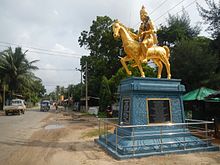Cankili II
You can help expand this article with text translated from the corresponding article in Tamil. (July 2019) Click [show] for important translation instructions.
|
| Cankili II | |
|---|---|
| King of Jaffna | |
 | |
| Reign | 1617–1619 |
| Predecessor | Ethirimana Cinkam (Parasasekaran VIII) |
| Successor | Portuguese conquest |
| Died | 1619 |
| Tamil | சங்கிலி குமாரன் |
| Sinhala | සංකිලි |
| House | Aryacakravarti dynasty |
Cankili II (Tamil: சங்கிலி குமாரன், romanized: Caṅkili Kumāraṉ; died 1621), also spelled Sangili) was the last king of the Jaffna kingdom and was a usurper who came to throne with a palace massacre of the royal prince and the regent Arasa-kesari in 1617. His regency was rejected by the Portuguese colonials in Colombo, Sri Lanka. His reign was secured with military forces from the Thanjavur Nayaks and Karaiyar captains. He was defeated by the Portuguese in 1619 and was taken to Goa and beheaded. With his death the Aryacakravarti line of Kings who had ruled the kingdom for over 300 years came to an end.[1]
Usurping the throne
[edit]With the death of Ethirimana Cinkam in 1617, there were three claimants to the throne. One was Cankili II, a nephew of the king. The other two claimants were the king's brother Arasakesari and a powerful chieftain Periye Pillai Arachchi. Ethirimana Cinkam's son, a minor was proclaimed as king with Arasakesari as regent.[2] Cankili II killed the claimants to the throne and other princes of royal blood and usurped the throne.[1]
Cankili II was, under the Portuguese, made the governor of Jaffna in 1617 and paid tribute to them on the promise that he had no contact with the Karaiyar captains.[3][4]
Local uprising
[edit]
The palace massacre created unrest among the people of the Jaffna kingdom. Migapulle Arachchi, the son of Periye Pillai Arachchi, with the aid of the Portuguese drove Cankili to Kayts in August–September 1618. Cankili had to seek aid from Raghunatha Nayak, the king of Thanjavur Nayak kingdom, who sent an army of 5000 men under the command of Khem Nayak (also known as Varunakulattan) to put down the uprising.[6]
Downfall
[edit]By June 1619, there were two Portuguese military expeditions to the Jaffna kingdom: a naval expedition which was repulsed by Khem Nayak and his troops, and a land expedition by Filipe de Oliveira and his army of 5,000, which was eventually able to defeat Cankili.[7]
Cankili's remaining soldiers were beheaded by Portuguese without trial. Cankili himself was taken to Goa and brought to trial by a High Court for treason where he was found guilty and sentenced to death by beheading. During his imprisonment, he was constantly visited by priests of the convent of St. Francis. Cankili then declared that he wished to be a Christian. He and his Queen were robed for baptism according to their status, and the priests baptized Cankili under the name Dom Filipe and also baptized his Queen under the name of Dona Margarida of Austria, with Archbishop Dom Frey Cristvao de Lisboa, serving as their godfather. They were baptized in the presence of the great Catholic Church dignitaries with all regal pomp.[8][9]
Cankili was executed in 1621. According to Fr. Fernao de Queyroz, "A theatre was prepared in the courtyard of the Custom house draped in mourning; on it a carpet with a cushion of red velvet; whither he came accompanied by many Religious of St. Francis who helped him to die well. He did not consent to have his hands tied, saying that it was not necessary because he died for his faults with great pleasure and as he uttered the "sweet name of Jesus" his head was cut off. After his death, he was dressed in the habit of St. Francis as he had asked when living and being carried by the same Religious in procession, he was buried in their Chapter-hall. His queen retired into the house of converts where she lived an exemplary Christian life."[9]
The surviving members of the royal family were also taken to Goa and asked to become monks or nuns in the holy orders. Most obliged, and their celibacy avoided the production of further claimants to the Jaffna throne.[10][11]
See also
[edit]Notes
[edit]- ^ a b Vriddhagirisan, V. (1942). The Nayaks of Tanjore. Annamalai University: Annamalai University Historical Series. pp. 77, 80, 81, 91. ISBN 9788120609969.
- ^ Amātyāṃśaya, Ceylon Adhyāpana saha Saṃskr̥tika Kaṭayutu pil̥ibanda (1969). Education in Ceylon: a centenary volume. Ministry of Education and Cultural Affairs. p. 320.
- ^ Rambukwelle, P. B. (1996). The Period of Eight Kings. P.B. Rambukwelle. p. 96. ISBN 9789559556527.
- ^ DeSilva, Chandra Richard (1972). The Portuguese in Ceylon, 1617-1638. University of London: School of Oriental and African Studies. p. 95.
- ^ Kunarasa, K The Jaffna Dynasty, P4
- ^ DeSilva, Chandra Richard (1972). The Portuguese in Ceylon, 1617–1638. University of London: School of Oriental and African Studies. p. 73.
- ^ Vriddhagirisan, V. (1942). The Nayaks of Tanjore. Annamalai University: Annamalai University Historical Series. pp. 80, 81, 91. ISBN 9788120609969.
- ^ Aldrich, Robert (18 January 2018). Banished Potentates: dethroning and exiling indigenous monarchs under British and French colonial rule, 1815–1955. Oxford University Press. p. 25. ISBN 9781526135315.
- ^ a b "The History of the Current Royal Family of Jaffna", The Official website of the Royal Family of Jaffna, retrieved 29 September 2023
- ^ Abeysinghe, T Jaffna Under the Portuguese, pp. 58–63
- ^ Gnanaprakasar, S A critical history of Jaffna, pp. 153–172
References
[edit]- Vriddhagirisan, V (2007). Nayaks of Tanjore. New Delhi: Asian Educational Services. pp. V, 77–8, 80–1, 90–2. ISBN 978-8120609969.
- Abeysinghe, Tikiri (2005). Jaffna under the Portuguese. Colombo: Stamford Lake. p. 66. ISBN 955-1131-70-1.
- Kunarasa, K (2003). The Jaffna Dynasty. Johor Bahru: Dynasty of Jaffna King’s Historical Society. p. 122. ISBN 955-8455-00-8.
- Gnanaprakasar, Swamy (2003). A Critical History of Jaffna (review of Yalpana Vaipava Malai). New Delhi: Asian Educational Services. p. 122. ISBN 81-206-1686-3.
